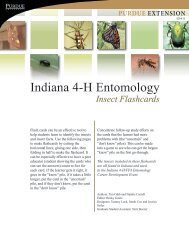Pink Gypsy Moth - aphis - US Department of Agriculture
Pink Gypsy Moth - aphis - US Department of Agriculture
Pink Gypsy Moth - aphis - US Department of Agriculture
Create successful ePaper yourself
Turn your PDF publications into a flip-book with our unique Google optimized e-Paper software.
Appendix A. Geographic distribution and comparison <strong>of</strong> climate zones. To<br />
determine the potential distribution <strong>of</strong> a quarantine pest in the <strong>US</strong>, we first collected<br />
information about the worldwide geographic distribution <strong>of</strong> the species (Table A1).<br />
Using a geographic information system (e.g., ArcView 3.2), we then identified which<br />
biomes (i.e., habitat types), as defined by the World Wildlife Fund (Olson et al. 2001),<br />
occurred within each country or municipality reported An Excel spreadsheet<br />
summarizing the occurrence <strong>of</strong> biomes in each nation or municipality was prepared. The<br />
list was sorted based on the total number <strong>of</strong> biomes that occurred in each<br />
country/municipality. The list was then analyzed to determine the minimum number <strong>of</strong><br />
biomes that could account for the reported worldwide distribution <strong>of</strong> the species.<br />
Countries/municipalities with only one biome were first selected. We then examined<br />
each country/municipality with multiple biomes to determine if at least one <strong>of</strong> its biomes<br />
had been selected. If not, an additional biome was selected that occurred in the greatest<br />
number <strong>of</strong> countries or municipalities that had not yet been accounted for. In the event <strong>of</strong><br />
a tie, the biome that was reported more frequently from the entire species’ distribution<br />
was selected. The process <strong>of</strong> selecting additional biomes continued until at least one<br />
biome was selected for each country. Finally, the set <strong>of</strong> selected biomes was compared to<br />
only those that occur in the <strong>US</strong>.<br />
Table A1. Reported geographic distribution <strong>of</strong> Lymantria mathura:<br />
Locations<br />
References<br />
Asia (southeast) (Roonwal 1979b, Baranchikov et al. 1995)<br />
Bangladesh (Rosovsky 2001, CAB 2004)<br />
China (Wileman 1918, Zhang 1994, Pucat and Watler 1997,<br />
Gries et al. 1999, Rosovsky 2001, Khrimian et al. 2004)<br />
China (Beijing) (Lewis et al. 1984)<br />
China (Dunhua) (Lewis et al. 1984, Odell et al. 1992)<br />
China (Heilogjiang Province) (CAB 2004)<br />
China (Heilongjiang Province - Menjiagang) (Lewis et al. 1984, Odell et al. 1992)<br />
China (Hong Kong) (Mohn 1993, Rosovsky 2001, CAB 2004)<br />
China (Jiaohe) (Lewis et al. 1984)<br />
China (Jingpo Hu) (Lewis et al. 1984)<br />
China (Manchuria) (Wileman 1918, Pucat and Watler 1997)<br />
China (north) (Zlotina et al. 1998)<br />
China (northeast) (Wallner et al. 1995, Rosovsky 2001)<br />
China (Yabuli) (Lewis et al. 1984)<br />
China (Yunnan) (Schintlmeister 2004)<br />
India<br />
(Wileman 1918, Browne 1968, Zhang 1994, Pucat and<br />
Watler 1997, Zlotina et al. 1998, Gries et al. 1999,<br />
Rosovsky 2001, CAB 2004, Khrimian et al. 2004)<br />
India (Assam) (Beeson 1941, Roonwal 1953, Roonwal et al. 1962,<br />
Roonwal 1979a, b)<br />
India (Bengal - northeast) (Schintlmeister 2004)<br />
India (Darjeeling District - Tukdah) (Sevastopulo 1947)<br />
India (Darjeeling District) (Schintlmeister 2004)<br />
India (north)<br />
(Wileman 1918, Beeson 1941, Roonwal 1953, Roonwal et<br />
al. 1962, Schintlmeister 2004)<br />
CAPS PRA: Lymantria mathura 15
















